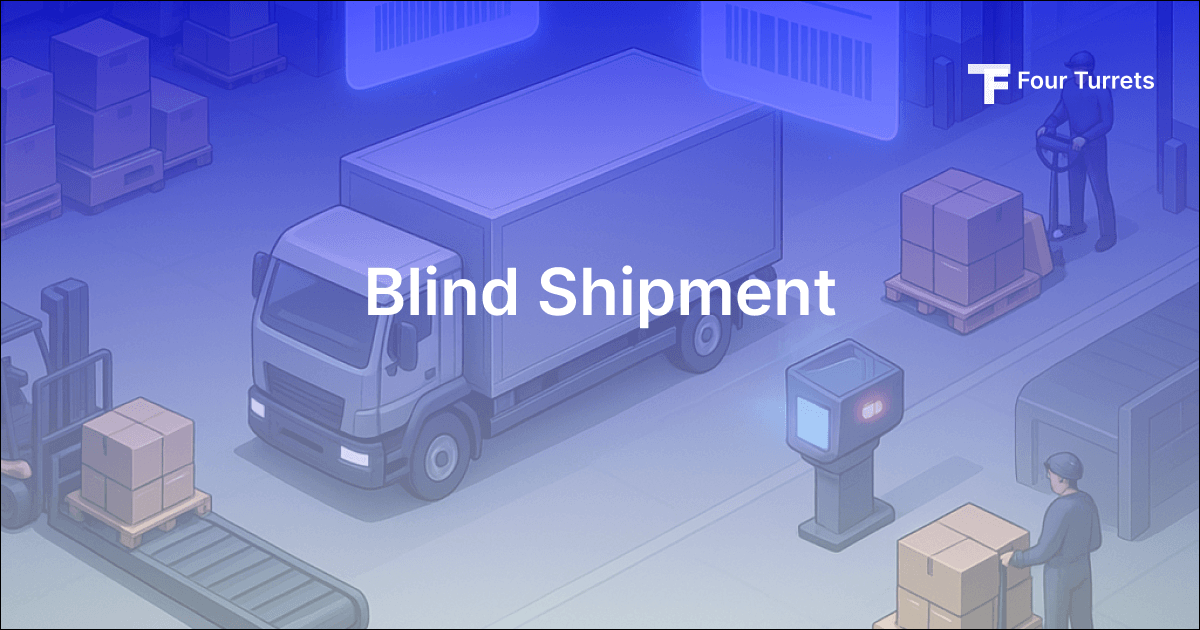The world needs fast-paced supply chain environment, maintaining confidentiality and efficiency for the businesses. One logistics strategy that helps achieve this is blind shipment—a method that keeps the identities of shippers, consignees, or both, confidential during the shipping process. Whether you’re a distributor, manufacturer, or third-party logistics provider, understanding blind shipping can help you protect your business relationships and streamline your freight operations.
What is a Blind Shipment?
A blind shipment occurs when the identity of the shipper, consignee, or both is intentionally concealed from one or more parties involved in the transaction. This is commonly requested by distributors who want their suppliers to drop-ship products directly to customers, making it appear as if the goods are shipped from the distributor rather than a third-party manufacturer or shipper.
For example, if a distributor sells a product but does not want the end customer to know the manufacturer, they can arrange a blind shipment. The shipping documents are modified so that the manufacturer’s details are hidden, and only the distributor’s information is visible to the consignee.
How Does Blind Shipping Work?
Blind shipping involves careful coordination between all parties in the supply chain. Here’s how the process typically unfolds:
Order Placement:
The distributor receives an order from the customer and places a corresponding order with the manufacturer or supplier.Shipping Document Preparation:
The distributor requests a blind shipment, instructing the supplier to ship the goods directly to the customer. The shipping documents are prepared to hide the supplier’s identity, often replacing it with the distributor’s details.Freight Pickup and Delivery:
The freight carrier picks up the shipment from the supplier and delivers it to the consignee (customer). The carrier may receive special instructions to ensure the blind shipment process is followed.Consignee Receives Goods:
The customer receives the goods, believing they came directly from the distributor, with no indication of the original supplier.
This process requires precise communication and documentation to avoid confusion and ensure the shipment reaches its destination without revealing confidential information.
Why Use Blind Shipments?
Blind shipments are used for several strategic reasons:
Protecting Business Relationships:
Distributors often want to prevent customers from bypassing them and purchasing directly from the manufacturer. Blind shipping helps maintain the distributor’s role in the supply chain.Brand Consistency:
By controlling the shipping documents, distributors can ensure that all shipments appear to come from their brand, enhancing customer loyalty and trust.Supply Chain Confidentiality:
Blind shipping keeps the supply chain confidential, which can be crucial in competitive industries where supplier relationships are a valuable asset.
Types of Blind Shipments
There are generally two types of blind shipments:
Single Blind Shipment:
Only the consignee is unaware of the shipper’s information. The shipper knows the consignee, but the consignee does not know the shipper.Double-Blind Shipment:
Both the shipper and the consignee are unaware of each other’s identities. This is less common but can be arranged for maximum confidentiality.
Key Parties Involved
Shipper:
The party sending the goods, which could be a manufacturer or supplier.Consignee:
The recipient of the goods, usually the end customer.Distributor:
The intermediary who arranges the blind shipment to protect their relationship with the customer.Freight Carrier:
The logistics provider responsible for transporting the goods. They must be informed about the blind shipment to handle the shipping documents correctly.
Preparing for a Blind Shipment
Proper preparation is essential for a successful blind shipment. Here are the key steps:
Accurate Shipping Documents:
Ensure all shipping documents, including the bill of lading and packing list, reflect the correct information as per the blind shipment arrangement.Clear Communication:
All parties, especially the freight carrier, must be informed about the blind shipment to avoid accidental disclosure of confidential information.Complete Pick-Up and Delivery Information:
Provide the carrier with all necessary details for pick-up and delivery, while ensuring the shipper or consignee information is concealed as required.Compliance with Regulations:
Make sure the blind shipment complies with all relevant shipping and trade regulations to avoid legal issues.
Pros and Cons of Blind Shipping
Pros:
- Maintains confidentiality in the supply chain
- Protects distributor-customer relationships
- Enhances brand consistency
- Can streamline logistics by shipping directly from supplier to customer
Cons:
- Requires meticulous documentation and communication
- Potential for confusion if instructions are unclear
- May incur additional fees from carriers for handling blind shipments
- Risk of errors if shipping documents are not properly managed
When Should You Use Blind Shipping?
Blind shipping is ideal for businesses that:
- Rely on third-party suppliers but want to maintain direct relationships with customers
- Operate in highly competitive markets where supplier information is sensitive
- Need to ship products directly from the manufacturer to the customer for efficiency
Conclusion
Blind shipment and blind shipping are powerful tools for maintaining confidentiality, protecting business relationships, and optimizing your supply chain. By understanding the process and preparing the right documentation, you can leverage blind shipping to enhance your operations and customer satisfaction.
Ready to streamline your procurement and shipping processes?
Connect with the Four Turrets team today to discover how we can help you manage your blind shipments and optimize your supply chain for maximum efficiency and confidentiality.
Is blind shipping legal and safe?
Yes, blind shipping is legal and widely used in the freight industry. However, it’s essential to ensure all documentation is accurate and that the process complies with trade regulations to avoid any legal complications.
Can any carrier handle blind shipments?
Not all carriers offer blind shipping services. It’s important to work with a freight provider experienced in handling blind shipments and familiar with the necessary documentation and procedures.
What information is hidden in a blind shipment?
Typically, the shipper’s or consignee’s identity and address are concealed on the shipping documents, depending on the arrangement. The carrier will only see the information necessary for pick-up and delivery.



